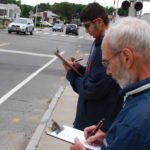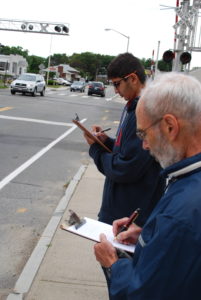
By Sumner Brown
Belmont has turned a corner about how we think of traffic. Twenty years ago, our hope was to find ways to make it easier for cars and trucks to pass through Belmont. Now our objective is to protect residential streets from rush-hour traffic and make life easier for pedestrians and bicyclists. The Belmont Citizens Forum has played a part in our traffic turnaround.
In 2002, the Belmont Citizens Forum’s Planning and Zoning Committee brainstormed about Trapelo Road. They thought about bike lanes and lots of trees. The committee engaged graduate student classes at MIT and the Boston Architectural Center to create designs for Trapelo Road, and held public forums on the road and the designs. The town took over Trapelo Road’s redesign and incorporated many of the committee’s ideas into the road rebuild.
One insight from the Trapelo Road redesign is that when a road has limited intersections, there is no benefit in having four travel lanes. Eliminating useless traffic lanes leaves room for bicycles, pedestrians, and trees. Belmont Center has also benefited from this approach.
In 2017, no one had estimated how much of Belmont’s rush hour traffic was cut-through traffic, that is, taking shortcuts through residential neighborhoods. A high school student, Aryan Mehrotra, and I estimated cut-through traffic in four ways. Primarily we counted traffic at intersections where cars entered and left Belmont. We estimated that between 70 and 80 percent of rush hour traffic is cut-through traffic.
For about two hours every afternoon, Belmont roads are at capacity.
For about two hours every afternoon, Belmont roads are at capacity. Cars cannot get through Belmont any faster. The next year the town had professional traffic engineers count traffic, and they reached the same conclusion (bit.ly/TACTrafStudy2018).
Another Belmont Citizens Forum Newsletter article (bit.ly/BCF2017Traffic), about Concord Avenue traffic and the controversial Belmont Day School’s proposal to build its barn, described the toxic effect of traffic, most of which is cut-through. This was learned from a bit of traffic counting.
These traffic counts demonstrated the irritation generated by traffic, and led to plans to mitigate commuter traffic overflowing into residential neighborhoods.
Sumner Brown is a director of the Belmont Citizens Forum.




Sorry, the comment form is closed at this time.